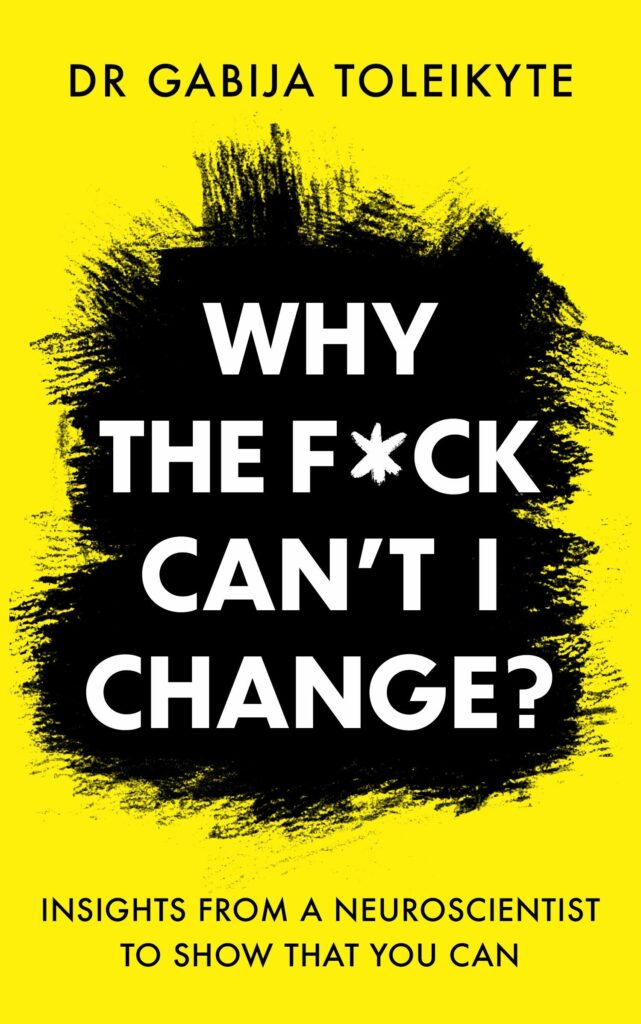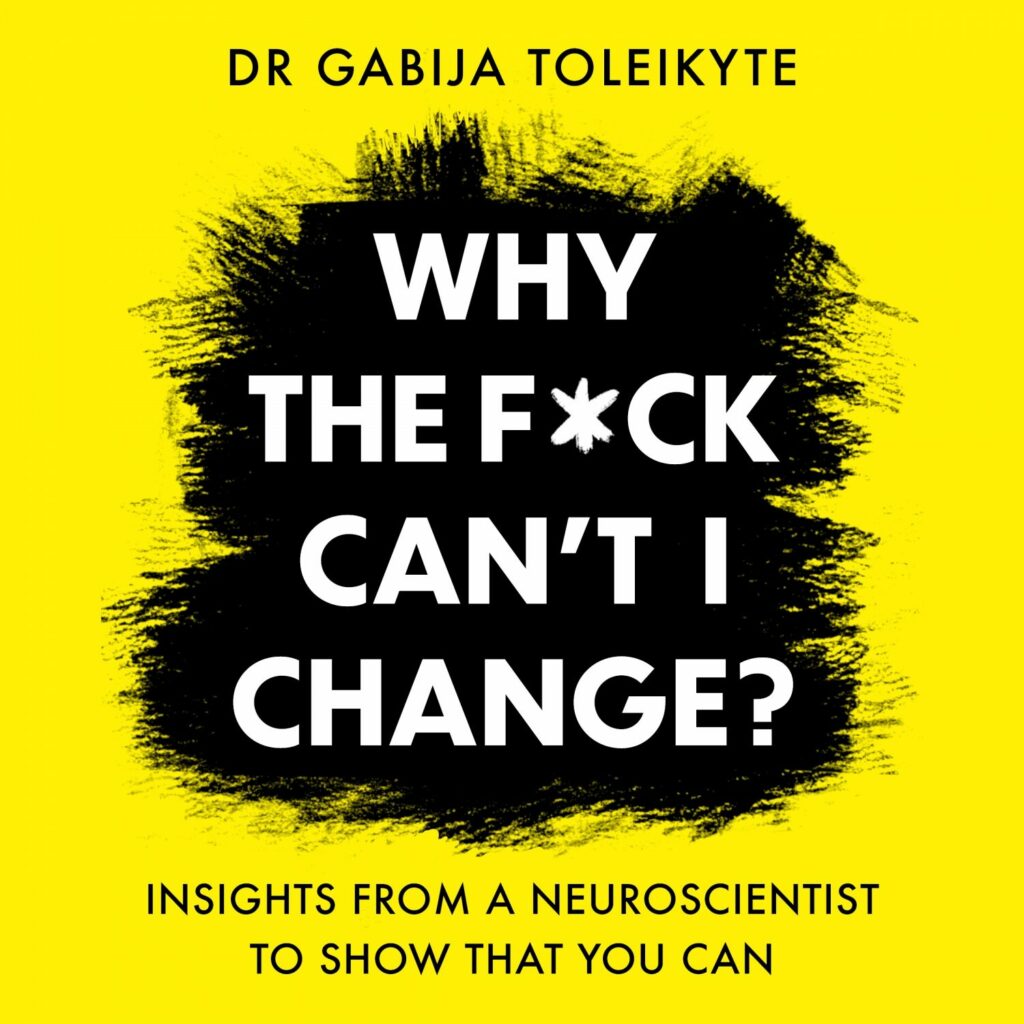Why the F*ck Can’t We Change?
In her new groundbreaking bestseller Why the F*ck Can’t I Change, Dr Gabija Toleikyte shows how you can banish bad habits for good and transform your life. Read an exclusive extract here.

Dr Gabija Toleikyte
In her new groundbreaking bestseller Why the F*ck Can’t I Change, Dr Gabija Toleikyte shows how you can banish bad habits for good and transform your life. Using neuroscience and behavioural analysis she explains how you can train your brain to make change last. Read an exclusive extract below:
Have you ever come up with amazing New Year’s resolutions like losing weight, starting to save money, setting up your own business, exercising regularly, changing your career, eating more healthily or quitting smoking? You probably pumped yourself up full of enthusiasm and the belief that this year will be very different.
Fast-forward, and what happened a month down the line? If you are like the majority of us, you probably went back to where you started. This is something I see in most of my coaching clients and the attendees of my seminars, my friends and, to be honest, in my own life. We all do it.
In my coaching practice, I have seen people struggling to change harmful habits for years and even decades. When I first began coaching, I was mainly working with university professors, department heads and lecturers. And, guess what, they faced the same problems too. Some struggled to stop procrastinating and were always leaving things to the last minute and missing important deadlines. Others could not force themselves to eat more healthily or exercise, even experiencing serious health issues. Other clients attended workshop after workshop on empowering leadership and still, while under stress, struggled to incorporate all the useful insights they had learned in practice.
The process of trying and failing to change is totally soul- destroying – we have learned to believe that if only we try hard enough and have the willpower, we should be able to change. When we fail to change, we start to doubt our own abilities and personalities, and we develop low self-esteem. The unrealistic expectations we have for our brains are not only bad for our own relationship with ourselves, but also, by causing additional stress, make it even harder for us to create real, lasting change. Thus, learning what we can realistically expect from our brains and having practical ways to create change can break this vicious cycle.
Our brains resist sudden change for multiple reasons. Humans are creatures of habit, because following habits automatically requires a lot less energy and mental space, freeing us up to focus on other things. Also, familiarity comforts the emotional centres of our brains. We form habits subconsciously without even realising it and often struggle to change them. Each time we try and fail to implement a change, we accumulate disappointment and start to lose hope. Everybody does it.
In order to stop repeating past mistakes, we need to understand why we formed these habits in the first place, and what we got out of it. Our actions always feed important needs, such as safety, variety, significance, connection. If we didn’t get anything from our actions, we wouldn’t do them anymore. That’s why we cannot simply get rid of old habits; we need first to understand the purpose they serve. Only then can we work out how to get the same rewards in a better way. That’s where this book comes in.
To implement lasting change, we need to manage conflict between different centres of the brain. We can group the areas of the brain into three major classes, based on our evolutionary development: the lizard brain, the mammal brain and the human brain. These three brain classes are in fact groupings of multiple areas of the brain, but for the sake of simplicity, I’ll just refer to ‘lizard’, ‘mammal’ and ‘human’ brains.
The lizard brain controls automatic functions such as breath- ing, heartbeat and digestion, and is essentially in place before we are born. The mammal brain automatises our actions – creating habits, physical skills and remembering past events – to ensure we can survive in our environment. The mammal brain’s main objective is to keep us safe, and communicates ‘safe/not safe’ to our other centres by creating emotions. The human brain is the smartest and the most up-to-date part, and enables us to make sense of the world, learn, and have individual personality traits, language, abstract thoughts and empathy for others.
Together, these brain centres enable us to make sound decisions, resist temptation, control our temper and understand other people. But this divide of functions within the brain can sometimes create problems. The mammal brain always seeks safety and pleasure, whereas the human brain wants to make the best choices, to learn, develop and create change, to keep growing and optimising our lives. This can often lead to inner conflict.
In situations of uncertainty or threat, the mammal brain creates the emotions we hate such as anger, jealousy, fear and anxiety. The mammal brain’s aim here is to push us to avoid uncertain or threatening situations. As if stirring up negative emotions wasn’t powerful enough, the mammal brain can temporarily ‘switch off’ the rational centres of the brain, making us incapable of rationally assessing the situation and often causing behaviour we later regret. In other words, the human brain, which we might see as the responsible adult in the room, gets shut down.
In order to make the best decisions, have the most fulfilling relationships and create lasting change in our lives, we need to provide our brains with three things: enough energy for the human brain, especially the smartest centre of it called the prefrontal cortex (PFC for short), safety for the mammal brain and enough repetition to create strong neural networks we call ‘brain highways’.
Moreover, to change our behaviour in areas such as decision- making, communication and relationship dynamics, we also need to know what conditions are needed for our brains to function optimally.
Why the F*ck Can’t I Change?
Dr Gabija Toleikyte
Change is hard and emotional, but it’s not as impossible as you think…
-
Ebook
-
Audiobook
-
Paperback

